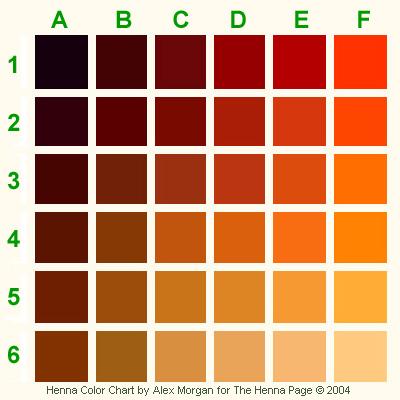|
The Henna Color Chart Alex Morgan for The Henna Page ©2004  This is a chart of henna stain colors. The henna stain on your skin will look different because henna is a translucent stain, blending with your skin tone. Henna artists often want to
talk about their henna stain color, and
Henna Page is providing this chart to facilitate this discussion.
If you need to describe a color, compare it to this chart, and people will know what you're referring to! Henna has a dye molecule,
Lawsone, also known as hennotannic acid.
Back to The
Encyclopedia of Henna IndexThis molecule breaches and
saturates the topmost layer of your skin, staining the skin cells.
There are many factors that affect the stain color henna leaves on your skin. Your
skin may be naturally alkaline or acidic.
Alkalies oxidize the stain to a
darker color.
Your skin may be naturally alkaline, or may be exposed to an alkaline. Some
parts of your skin take up more dye than other parts.
Thin oily or newly formed skin
takes up less stain than thick, corneated skin.
Different
hennas have differing amounts of Lawsone,
Some henna powders have
high dye content. Some don't.
There are many things which
affect a henna's Lawsone level: climate, soil, processing, and storage.
Different
mixes and applications release differing amounts of Lawsone
If you have a mix that
facilitates dye release, you'll get the most stain from your henna
Different temperatures affect dye release, skin saturation, and oxidation. Different durations of applications affect skin saturation. Can't find what you're looking for? Try: The Henna Page Main Index http://www.hennapage.com/henna/mainindex.html *"Henna,
the
Joyous Body Art"
the Encyclopedia of Henna Catherine Cartwright-Jones © 2000 registered with the US Library of Congress TXu 952-968 |